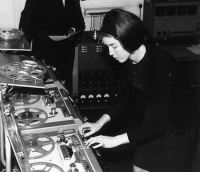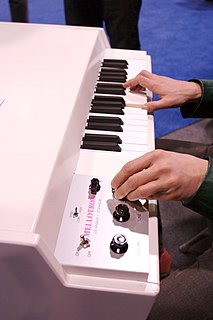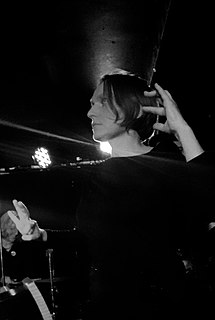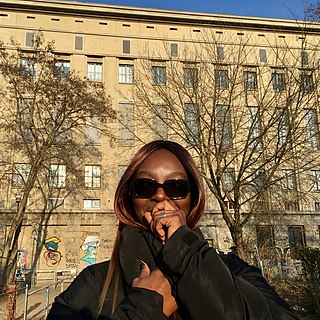Electronic music is music that employs electronic musical instruments, digital instruments, or circuitry-based music technology in its creation. It includes both music made using electronic and electromechanical means. Pure electronic instruments depended entirely on circuitry-based sound generation, for instance using devices such as an electronic oscillator, theremin, or synthesizer. Electromechanical instruments can have mechanical parts such as strings, hammers, and electric elements including magnetic pickups, power amplifiers and loudspeakers. Such electromechanical devices include the telharmonium, Hammond organ, electric piano and the electric guitar.

An electronic musical instrument or electrophone is a musical instrument that produces sound using electronic circuitry. Such an instrument sounds by outputting an electrical, electronic or digital audio signal that ultimately is plugged into a power amplifier which drives a loudspeaker, creating the sound heard by the performer and listener.
Ambient music is a genre of music that emphasizes tone and atmosphere over traditional musical structure or rhythm. A form of instrumental music, it may lack net composition, beat, or structured melody. It uses textural layers of sound which can reward both passive and active listening and encourage a sense of calm or contemplation. The genre is said to evoke an "atmospheric", "visual", or "unobtrusive" quality. Nature soundscapes may be included, and the sounds of acoustic instruments such as the piano, strings and flute may be emulated through a synthesizer.

The BBC Radiophonic Workshop was one of the sound effects units of the BBC, created in 1958 to produce incidental sounds and new music for radio and, later, television. The unit is known for its experimental and pioneering work in electronic music and music technology, as well as its popular scores for programmes such as Doctor Who and Quatermass and the Pit during the 1950s and 1960s.

Digital music technology encompasses digital instruments, computers, electronic effects units, software, or digital audio equipment by a performer, composer, sound engineer, DJ, or record producer to produce, perform or record music. The term refers to electronic devices, instruments, computer hardware, and software used in performance, playback, recording, composition, mixing, analysis, and editing of music.
Electronica is both a broad group of electronic-based music styles intended for listening rather than strictly for dancing and a music scene that started in the early 1990s in the United Kingdom. In the United States, the term is mostly used to refer electronic music generally.
A music sequencer is a device or application software that can record, edit, or play back music, by handling note and performance information in several forms, typically CV/Gate, MIDI, or Open Sound Control (OSC), and possibly audio and automation data for DAWs and plug-ins.

Daphne Oram was a British composer and electronic musician. She was one of the first British composers to produce electronic sound, and was a pioneer of musique concrète in the UK. As a co-founder of the BBC Radiophonic Workshop, she became a central figure in the evolution of electronic music. Her uncredited scoring work on the 1961 film The Innocents helped to pioneer the electronic soundtrack.

Delia Ann Derbyshire was an English musician and composer of electronic music. She carried out pioneering work with the BBC Radiophonic Workshop during the 1960s, including her electronic arrangement of the theme music to the British science-fiction television series Doctor Who. She has been referred to as "the unsung heroine of British electronic music", having influenced musicians including Aphex Twin, the Chemical Brothers and Paul Hartnoll of Orbital.

Drawn-on-film animation, also known as direct animation or animation without camera, is an animation technique where footage is produced by creating the images directly on film stock, as opposed to any other form of animation where the images or objects are photographed frame by frame with an animation camera.
Frederick Charles Judd, (1914–1992) was known for his work in amateur radio, particularly his designs of the Slim Jim and ZL Special aerial antennas. He was also an inventor and proselytiser of early British electronic music.
The Variophone was developed by Evgeny Sholpo in 1930 at Lenfilm Studio Productions, in Leningrad, the Soviet Union, during his experiments with graphical sound techniques, also known as ornamental, drawn, paper, artificial or synthetic sound. In his research Sholpo was assisted by the composer Georgy Rimsky‐Korsakov. The Variophone was an optical synthesizer that utilized sound waves cut onto cardboard disks rotating synchronously with a moving 35mm movie film while being photographed onto it to produce a continuous soundtrack. Afterwards this filmstrip is played as a normal movie by means of a film projector. Being read by photocell, amplified and monitored by a loudspeaker, it functions as a musical recording process.

A synthesizer is an electronic musical instrument that generates audio signals. Synthesizers typically create sounds by generating waveforms, through methods including subtractive synthesis, additive synthesis and frequency modulation synthesis. These sounds may be altered by components such as filters, which cut or boost frequencies; envelopes, which control articulation, or how notes begin and end; and low-frequency oscillators, which modulate parameters such as pitch, volume, or filter characteristics affecting timbre. Synthesizers are typically played with keyboards or controlled by sequencers, software or other instruments, and may be synchronized to other equipment via MIDI.

The use of electronic music technology in rock music coincided with the practical availability of electronic musical instruments and the genre's emergence as a distinct style. Rock music has been highly dependent on technological developments, particularly the invention and refinement of the synthesizer, the development of the MIDI digital format and computer technology.
Graphical sound or drawn sound is a sound recording created from images drawn directly onto film or paper that were then played back using a sound system. There are several different techniques depending on the technology employed, but all are a consequence of the sound-on-film technology and based on the creation of artificial optical polyphonic sound tracks on transparent film.
The timeline of music technology provides the major dates in the history of electric music technologies inventions from the 1800s to the early 1900s and electronic and digital music technologies from 1917 and electric music technologies to the 2010s.

Sarah Angliss is a British composer, multi-instrumentalist, producer and robotic artist who composes for film, theatre and the concert stage, including her own live performance. Her music uses voices, orchestral and ancient instruments, augmented with Max, electronics and her own hand-built music machines. Angliss is also a professional thereminist and recorder player and applies her own extended and electronic techniques to both instruments. In November 2018 she received a Composer's Award from the Paul Hamlyn Foundation and on 8 December 2021 the Ivors Academy awarded her its Visionary Award, commenting that she “stays true to her artistic concepts, to create unique compositions that connect to the listener with emotional depth and great beauty, never failing to leave a lasting impression.” Alongside her performance, she researches the history of sound culture, presenting topics in print and on radio, work that informs her sound design for historic sites.
Shiva Feshareki is a British-Iranian experimental composer, turntable artist and radio presenter. As a turntablist, she plays her compositions solo or alongside classical orchestras. She was born in London in 1987. She obtained a Doctorate of Music from the Royal College of Music. In 2017 she was honoured with the Ivor Novello Award for Innovation.

Jo Thomas is a composer, sound artist, producer and performer of electronic music based in London. She works primarily with electronic sound, with a focus on fine detail and abstraction combining technological, biological and emotive thematic elements. Her work utilises a wide range of sound sources including field recordings, voice, glitch, and synthesised sounds from various sources, including her own self-built instruments.

Henrietta Smith-Rolla, is a British-born Ghanaian-Russian-German composer, producer and DJ based in Manchester, performing under the alias Afrodeutsche. Alongside her prolific DJ career, she has produced music for her own studio album, as well as music for television and film, including composing the score for BAFTA nominated short film Kamali.













